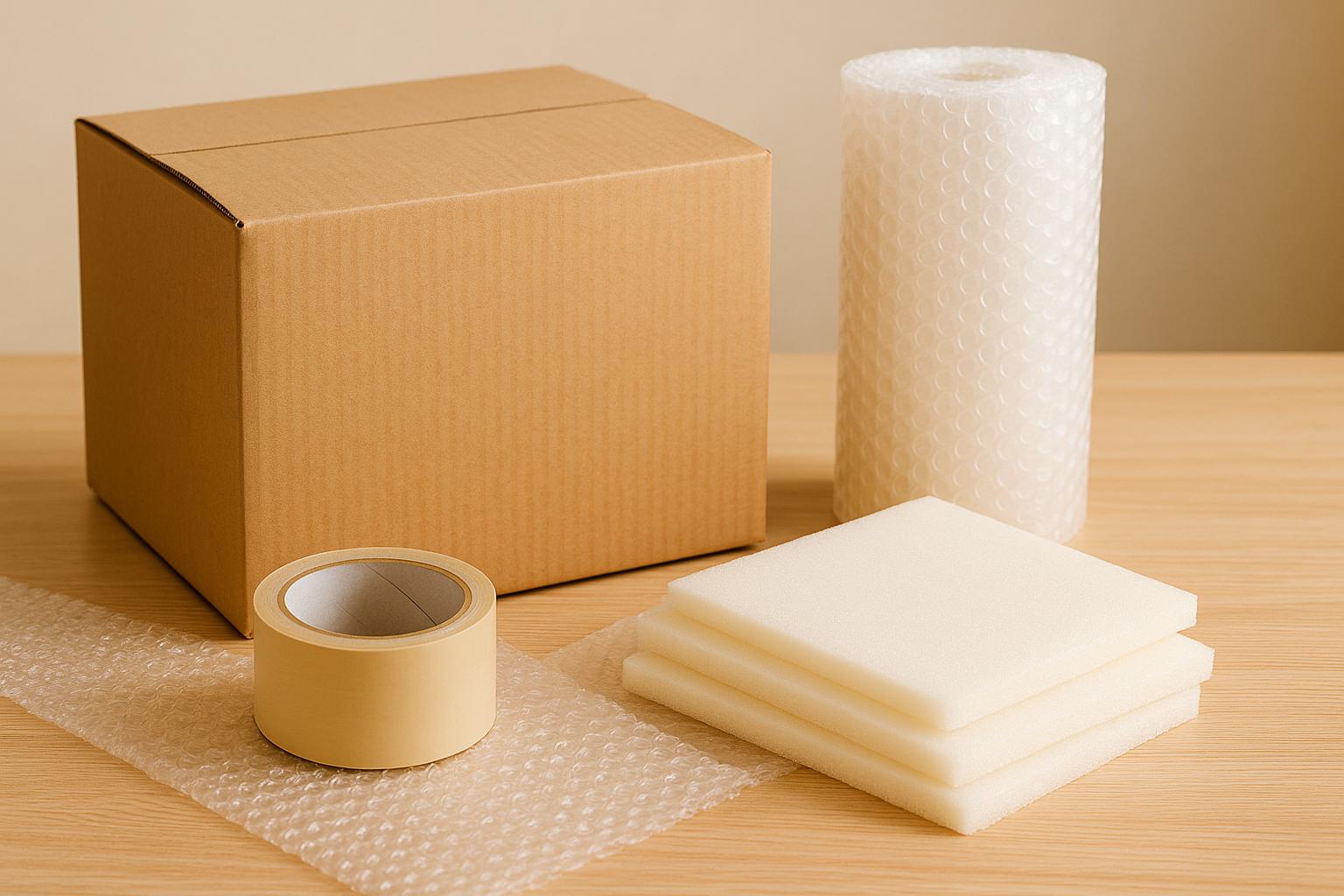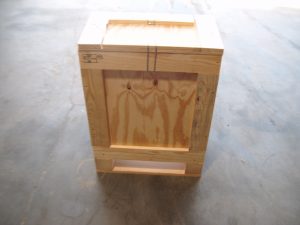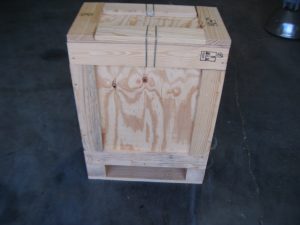Shipping fragile items? Here’s what you need to know: Proper packaging is critical. It minimizes damage, protects your reputation, and reduces costly returns. With 76% of consumers saying they’d stop buying from a brand after receiving a damaged product, getting this right isn’t optional.
Key Takeaways:
- Assess Fragility: Understand your item’s weak points (e.g., shock, moisture, temperature).
- Choose the Right Crate: Custom wooden crates tailored to size and weight offer the best protection.
- Use Cushioning: Add at least 3 inches of padding (bubble wrap, foam, or paper) around your item.
- Prevent Movement: Secure items with straps, bracing, or custom foam inserts.
- Protect Against Moisture: Use vapor barriers and desiccants for sensitive items.
- Label Clearly: Apply "Fragile" and "This Side Up" stickers for proper handling.
- Follow Regulations: Ensure ISPM 15 compliance for international wooden crate shipments.
Proper preparation ensures your items arrive safely, saving you money and maintaining customer trust. Let’s break it down step by step.
How to Package Fragile Items SAFELY for Shipping
How to Assess Your Item’s Fragility and Packaging Requirements
To start, you need to understand the specific vulnerabilities of each item. Every product has its own weak points that require tailored protection, and a detailed assessment is the first step toward ensuring proper packaging.
The trick is to go beyond the obvious. Sure, we all know glass is fragile, but the real challenge lies in figuring out how much force your particular item can endure and what kinds of damage it’s most at risk for.
How to Identify Fragility Factors
One reliable way to gauge fragility is by measuring the item’s g-factor – the maximum deceleration it can endure without sustaining damage. This scientific approach eliminates guesswork, providing a clear measure of how much shock your item can handle. Items with lower g-factors are more fragile. To determine this, you apply incremental shock until minor damage occurs; the highest safe deceleration becomes the g-factor.
Here’s a breakdown of typical fragility levels for various items:
| Fragility Level | G-Force Range | Examples |
|---|---|---|
| Extremely Fragile | 15–25 g’s | Missile guidance systems, precision test instruments |
| Very Delicate | 25–40 g’s | Shock-mounted instruments, electronic equipment |
| Delicate | 40–60 g’s | Aircraft accessories, electric typewriters, cash registers |
| Moderately Delicate | 60–85 g’s | Television receivers, aircraft accessories |
| Moderately Rugged | 85–115 g’s | Laundry equipment, refrigerators, appliances |
| Rugged | 115+ g’s | Heavy machinery |
Misjudging the g-factor can lead to problems. Overestimating it might result in packaging that’s too weak, leaving your item vulnerable to damage during shipping. Underestimating it, on the other hand, could mean spending more than necessary on overengineered packaging.
Beyond shock resistance, you should evaluate how your item reacts to impact, vibration, compression, and temperature changes. Fragility can also vary based on orientation – an item might be sturdy when upright but fragile when tilted or inverted. Material-specific weaknesses are another key consideration: electronics are sensitive to static and moisture, while glass is prone to shattering upon impact. Understanding these factors allows you to design packaging that meets your item’s unique needs.
Environmental conditions during transport – like temperature shifts, pressure changes, and humidity – can also harm delicate items. For instance, a precision instrument might survive moderate shocks but fail when exposed to excessive moisture.
Careful documentation of these findings is essential to ensure the right protective measures are in place.
How to Document Special Requirements
Thorough documentation ensures everyone handling the item understands its specific needs.
Start by creating a detailed inventory of fragile items, including their value for insurance purposes. Record dimensions, weight, and any special handling instructions for each item. If your product requires specific care – like remaining upright – make sure this is clearly communicated. Use bold labels, "Fragile" stickers, and instructions like "Handle with Care" and "This Side Up" on all sides of the package.
Include contact information for both the sender and recipient prominently on the packaging in case questions arise during handling.
For high-value items, it’s wise to document the fragile inventory before shipping. This can help with insurance claims and ensure accurate tracking. Be sure to include insurance details that state the insured value of the items in case of loss or damage. When assessing an item’s value, consider its sentimental importance as well as its monetary worth.
Categorizing items into high, medium, and low-risk fragility levels can streamline the process. This approach helps you allocate resources effectively – avoiding unnecessary overprotection for sturdy items while ensuring delicate ones get the care they need.
Finally, your documentation should address all potential threats and outline the necessary protective measures. This kind of detailed assessment is invaluable when selecting custom wooden crates or other packaging solutions to ensure your items are safe during transport.
How to Choose and Customize Wooden Crates for Maximum Protection
When it comes to shipping fragile or valuable items, the right wooden crate can make all the difference. A well-chosen and customized crate, designed with your item’s specific needs in mind, can protect against damage and ensure safe delivery.
Why Custom Wooden Crates Are Worth It
Custom wooden crates offer a level of protection that standard packaging simply can’t match. By tailoring the crate to your item’s exact size, weight, and fragility, you eliminate gaps that could lead to movement during transit. This reduces the risk of impacts and vibrations. For heavier loads, crates made from hardwood or structural-grade plywood can handle weights of several thousand pounds. You can also include features like tamper-evident seals and locks to prevent unauthorized access.
Key Design Features for Protection
The way your wooden crate is built plays a huge role in its ability to safeguard your items. Here’s what to consider:
- Wood Type: Hardwoods like oak or maple are ideal for heavy or fragile items, while softwoods like pine work well for lighter shipments.
- Thickness: For heavy-duty crates, use plywood at least 1.5 inches thick or wood planks that are ¾ to 1 inch thick.
- Fasteners and Construction: Nails and screws provide strong assembly but add weight, while adhesives offer a cleaner look but may not support very heavy loads. Framed structures add strength without bulk, and fully enclosed crates provide the best protection.
- Reinforcements: Metal corner brackets, steel bands, and crossbars can boost durability. Protective coatings that resist water, weather, and pests add another layer of security.
Inside the crate, additional features like padding, dividers, and straps can keep items secure. For easier handling, consider adding removable panels, wheels, or handles. If your shipment needs airflow, ventilation openings can be incorporated. To avoid damage, distribute heavy loads evenly to prevent pressure points from forming. For outdoor transport, waterproof sealants can help protect your shipment from the elements.
Finally, if your shipment is crossing international borders, your crate must meet specific requirements.
ISPM 15 Certification for International Shipping
Shipping internationally? Then your wooden crate must comply with ISPM 15 standards. These regulations, set by the International Plant Protection Convention (IPPC), aim to stop the spread of pests and diseases through wood packaging materials. With over 180 countries enforcing ISPM 15 rules, compliance is essential to avoid delays or rejections.
According to ISPM 15, wood thicker than 6 mm must be debarked and treated – either heat treated or fumigated with methyl bromide – before being stamped with a compliance mark. For heat treatment, the wood is heated to a core temperature of 56°C (132.8°F) for at least 30 minutes to kill pests without weakening the structure. The ISPM 15 mark includes the IPPC symbol, a country code, the treatment provider’s certification number, and the treatment method (e.g., Heat Treatment (HT) or Methyl Bromide (MB)).
To ensure compliance, work with certified suppliers who provide pre-treated and marked crates. Verify that the ISPM 15 markings are visible on at least two opposite sides of the crate and confirm that the wood is fully debarked. Staying informed about updates to these regulations is also crucial. Even with these requirements, ISPM 15-compliant crates can be customized in size, design, and labeling without sacrificing their protective qualities.
When choosing wood for your crate, prioritize strength and durability based on your shipping needs. Also, make sure the wood is legally sourced and sustainably harvested. If air freight is your shipping method, consider the crate’s weight to keep costs manageable.
How to Cushion and Secure Contents Inside the Crate
Once you’ve built your wooden crate, the next big step is making sure the items inside are properly cushioned and secured. A strong crate is only part of the equation – if the contents shift around during transit, damage is almost inevitable. Using the right cushioning materials and securing techniques can make all the difference between a safe delivery and a costly mishap.
How to Select Cushioning Materials
The cushioning material you choose should match your item’s weight, fragility, and shape. A general rule of thumb: use 3 inches of cushioning on all sides of the item for adequate protection. Here’s a breakdown of some commonly used materials and their best applications:
- Bubble wrap: Ideal for glassware and electronics, bubble wrap provides excellent shock absorption. It’s lightweight, cost-effective, and can handle significant impacts when layered and paired with quality corrugated boxes.
- Packing peanuts: Great for irregularly shaped items, packing peanuts fill empty spaces to prevent shifting. They offer 360-degree protection and come in traditional polystyrene or biodegradable options.
- Foam sheets and rolls: Perfect for items like furniture, mirrors, and electronics with flat or sensitive surfaces. Foam is non-abrasive and wraps snugly around items. Select foam density and thickness based on the item’s weight and fragility.
- Paper padding: A sustainable option for lightweight or moderately fragile items. Both kraft and recycled paper varieties are available, making this an eco-conscious choice.
- Air pillows: These are lightweight and space-efficient for filling voids in the crate. They’re also recyclable, adding an environmentally friendly touch to your packaging setup.
| Cushioning Material | Best For | Key Advantages |
|---|---|---|
| Bubble Wrap | Glassware, Electronics | Shock absorption, lightweight, budget-friendly |
| Packing Peanuts | Irregularly shaped items | Prevents shifting, fills spaces, all-around protection |
| Foam Sheets/Rolls | Furniture, Mirrors, Electronics | Non-abrasive, snug fit, customizable thickness |
| Paper Padding | Lightweight, moderately fragile items | Eco-friendly, recyclable |
| Air Pillows | Filling voids | Lightweight, recyclable, space-saving |
"Investing in packaging up front and making sure you’ve followed our recommended best practices are the best ways to ensure your fragile items are delivered safely." – FedEx
How to Prevent Movement and Impact Damage
Once you’ve selected the right cushioning materials, the next step is to secure the items in place. Simply filling gaps with loose material won’t cut it – immobilizing the contents is key to preventing damage.
- Blocking and bracing: Use pieces of lumber to create barriers that hold items in place inside the crate. This prevents shifting in any direction. For heavy or oddly shaped items, consider using wood or steel saddles attached to the crate’s base.
- Tie-downs and straps: Ratchet straps or tie-down devices help distribute weight evenly and keep items from sliding or lifting during transit.
- Securing items with wheels: For objects with casters or wheels, use a multi-point securing system. Add blocks to the front and back to stop sliding, brace the sides with wood pieces, and use straps anchored to the crate’s base for extra stability. This method was successfully implemented by Craters & Freighters in September 2021 for large, heavy items.
"Simply filling the space around a crated item with loose material typically is not enough to prevent it from moving. A more effective approach is to get the item into its crate or onto a wood pallet and then immobilize it with wood blocks or cradles that are screwed together to create a protective framework." – Craters & Freighters
- Custom foam inserts: For a tailored fit, precision-cut foam inserts conform to your item’s exact shape, eliminating movement while protecting against abrasion, vibration, and shock. Corrugated inserts can also be used for secondary protection without breaking the bank.
- Proper spacing: Always ensure there’s at least 2 inches of space between your items and the crate walls. Fill any gaps with void-fill material. Shake the crate lightly to check for movement – if anything shifts, repack until everything is completely secure.
For added security, screws are a better choice than nails for internal bracing, as they provide a stronger hold. For heavier loads, bolts might be necessary to maintain structural integrity.
"Your crating manufacturer can protect your product against damage from vibrations & impact by customizing the internal and external components to maximize safety." – Valley Box Company
Before shipping, inspect all cushioning materials and securing components to ensure they’re in good condition. Replace anything worn or damaged to avoid potential issues during transit. These steps, combined with a well-designed crate, provide a solid defense against shipping hazards.
sbb-itb-1c2a65d
How to Protect Against Moisture and Environmental Damage
Moisture, humidity, and temperature swings can wreak havoc on delicate items, causing rust, damaging electronics, or weakening wooden structures. Just like custom crates and cushioning protect against physical shocks, moisture-proofing and weatherproofing are essential to guard against environmental threats. Let’s dive into some practical ways to shield your items from these risks.
How to Use Vapor Barrier and Desiccant Solutions
Vapor barriers and desiccants work together to create a moisture-free environment for your items. Vapor barriers form a seal that keeps moisture out, while desiccants absorb any residual dampness inside the package.
Vapor barrier bags are a go-to solution for keeping moisture at bay. These sealable bags create a protective layer around your equipment, preventing environmental moisture from seeping in. To use them, wrap your items in a vapor barrier bag, vacuum out the air, and heat-seal it for maximum protection.
"We use sealable barrier bags as they are the most effective packaging solution available to protect against moisture damage caused by rain, humidity, condensation, salt spray and other harmful or corrosive agents capable of penetrating exterior packaging." – REID PACKAGING
Desiccant bags add another layer of defense by soaking up any remaining moisture inside the sealed space. Bob Cook from CDC Packaging explains: "Desiccant works like a sponge, soaking up any water vapor from the environment". The amount of desiccant you’ll need depends on factors like package size, the type of equipment, and the environmental conditions during transit. For shipments with sensitive electronics or metal components, desiccants can help prevent corrosion during shipping.
For extra-sensitive cargo, consider replacing the air inside the packaging with nitrogen gas. Nitrogen reduces the risk of corrosion by creating an inert, dry environment. Foil bags are another excellent option, especially for metals and electronics prone to oxidation. When planning your moisture protection strategy, think about the entire shipping route, including storage conditions along the way.
Weatherproofing and Tamper-Resistant Measures
While internal solutions like vapor barriers and desiccants protect your items from the inside, external weatherproofing and tamper-resistant measures add another layer of security.
Weatherproof sealing starts with materials that can handle moisture and extreme temperatures. For example, weatherproof paper for shipping labels ensures that critical information stays readable, even in challenging conditions.
Crate sealing techniques are also crucial. Pay close attention to seams and corners, sealing them with high-quality packing tape to block out moisture.
Temperature protection is vital for items that are sensitive to heat or cold. Products like cool shield bubble mailers or thermal bubble wrap can help regulate temperature changes. If your shipment has been exposed to cold temperatures, let it gradually adjust to warmer conditions before uncrating to prevent condensation from forming on cold surfaces.
Tamper-evident solutions offer peace of mind by showing if a package has been accessed during transit. Options include breakable seals, shrink bands, label seals, and tamper-evident tape. Water-activated tape is particularly effective, as it bonds more securely than standard tape and provides superior tamper resistance. It’s also a good idea to train your team to recognize signs of tampering and establish clear protocols for handling compromised shipments.
How to Ensure Compliance and Safe Shipping Practices
After conducting a thorough assessment and customizing your crates, the final step in protecting fragile items is ensuring compliance with regulations and following safe handling practices. Shipping delicate items safely isn’t just about sturdy packaging – it also requires strict attention to labeling, documentation, and professional handling to guarantee timely and secure delivery.
Labeling and Documentation Best Practices
Clear and visible labeling is your first line of defense against mishandling. Place fragile labels on multiple sides of the crate using bright, high-contrast colors to make sure handlers notice the item’s delicate nature from any angle. For items sensitive to orientation – like electronics or artwork – add "This Way Up" stickers to maintain proper alignment during transit.
For domestic shipments, ensure all documentation is complete and accurate. Include the recipient’s full name and a detailed street address. If you’re shipping valuable or one-of-a-kind items, consider purchasing shipping insurance to protect against potential loss or damage.
When shipping internationally, the paperwork becomes even more important. Customs forms must be computer-generated and include a detailed list of the shipment’s contents, along with their value and weight. Write delivery addresses in English and include all necessary details, such as the recipient’s full name, street address, city, state or province, postal code, and country. For destinations within the European Union, provide detailed descriptions of the contents on customs forms and research the specific import regulations and restrictions for the country you’re shipping to.
These steps not only help ensure smooth transit but also align with international shipping standards, as outlined in the compliance requirements below.
ISPM 15 Compliance for Wooden Crates
If you’re shipping wooden crates internationally, they must comply with ISPM 15 regulations. This means the wood must be heat-treated and stamped with the IPPC mark on two opposite sides of the crate. Non-compliance could lead to your shipment being impounded. To avoid issues, confirm that the wood is bark-free and request a heat treatment certificate from your packaging supplier.
Meeting these requirements is essential, but professional handling can further reduce the risks associated with shipping fragile or high-value items.
On-Site Packaging and Professional Handling Services
For items that are large, fragile, or particularly valuable, on-site packaging services are a smart way to minimize handling risks. Professional packers can come directly to your facility, managing everything from crating to pickup. This reduces the number of times your shipment is moved and ensures that packaging is done in a controlled environment.
Twin Oak Crates offers specialized on-site packaging services, bringing their expertise directly to you. Their approach ensures that your items are securely packaged from the start.
Additionally, many major carriers provide professional packing solutions with guarantees that cover the value of the item, shipping costs, and packaging expenses.
Proper staff training is another critical component of safe handling. Everyone involved in moving or handling fragile items should understand the specific risks and know how to use the correct lifting and moving equipment. Conducting regular audits can help identify potential issues and address them before they lead to costly errors.
Using pick-up services, where professionals handle transportation from your facility to the shipping carrier, is another effective way to lower risks – especially for heavy or awkwardly shaped items. When selecting professional services, choose providers with proven experience in handling items similar to yours and a clear understanding of your industry’s needs. The upfront investment in expert handling can save you from far greater expenses caused by damage or mishandling.
Conclusion: Key Takeaways for Secure Fragile Item Packaging
When it comes to shipping fragile items, a careful approach can save you from costly damages and protect your reputation. Start by identifying the specific vulnerabilities of your item – whether it’s sensitivity to shock, moisture, temperature, or orientation. Let these factors guide your choice of materials and packaging design.
The foundation of secure packaging lies in custom crates. Wooden crates with shock-absorbing features, built to meet ISPM 15 requirements for international shipping, offer robust protection. From there, proper cushioning and sealing ensure your items stay safe during transit.
"Investing in packaging up front and making sure you’ve followed our recommended best practices are the best ways to ensure your fragile items are delivered safely." – FedEx
A layered protection strategy works best. Start by wrapping each item individually with at least 3 inches of air-cellular cushioning material on all sides. Fill any empty spaces within the crate to prevent shifting during transit, and keep items at least 2 inches away from the crate walls for added safety.
Don’t overlook the importance of labeling and documentation. Clearly mark crates as fragile from multiple angles, use orientation indicators, and complete all necessary customs paperwork for international shipments. For extra peace of mind – especially with high-value or delicate items – consider hiring professional on-site packaging services to reduce handling risks.
FAQs
What should I consider when determining how fragile an item is for shipping?
When preparing a fragile item for shipping, it’s important to evaluate several critical aspects to ensure its safety:
- Material and structure: Is the item made from breakable materials like glass or ceramics? Does it include delicate parts or fine details that could easily be damaged?
- Handling risks: Consider the possible bumps, vibrations, or pressure the item might encounter during transit. Will it be stacked or handled multiple times?
- Environmental conditions: Think about how temperature changes, humidity, or moisture exposure could impact the item.
- Packaging needs: Make sure the packaging provides enough cushioning, stability, and protection to shield the item from external forces.
Taking these factors into account allows you to select the right packaging materials and methods to safeguard fragile items during transport.
What steps should I take to ensure my wooden crates meet ISPM 15 standards for international shipping?
Ensuring Compliance with ISPM 15 Regulations
If you’re using wooden crates for international shipping, it’s crucial to follow ISPM 15 regulations. This ensures your crates are treated and marked properly to meet global standards. Here’s what you need to know:
- The wood must be debarked to remove any remaining bark.
- It must undergo heat treatment at a temperature of at least 132.8°F (56°C) for a minimum of 30 minutes. This process eliminates harmful pests.
- Once treated, the crates need to be stamped with the official ISPM 15 mark. This mark is your proof of compliance and is required for customs clearance.
Taking these steps not only ensures your crates meet international regulations but also protects your goods during transit.
What’s the best way to cushion and secure fragile items inside a crate for safe shipping?
To ensure delicate items remain intact during shipping, focus on using effective cushioning and secure packing methods. Start by wrapping each item separately with at least 3 inches of protective material, such as bubble wrap or foam padding. Fill any gaps in the box with loose-fill materials like packing peanuts or crumpled paper to stop items from shifting around. For extra protection, consider using air-cellular padding or foam inserts to absorb shocks. A snug fit inside the box is key to reducing movement and lowering the chances of damage.



